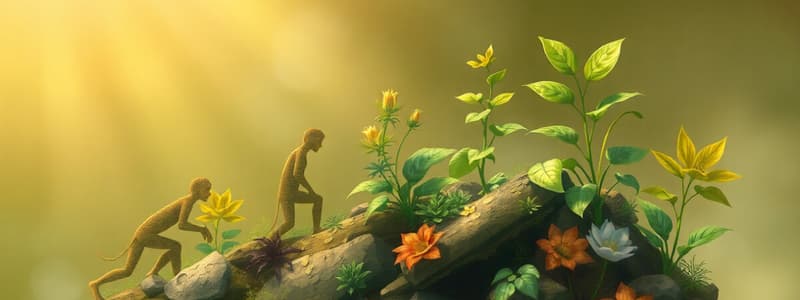Podcast
Questions and Answers
Green algae, the ancestor of land plants, can be associated with land plants because of their chloroplasts. Their chloroplasts are structurally arranged in ____ their cells.
Green algae, the ancestor of land plants, can be associated with land plants because of their chloroplasts. Their chloroplasts are structurally arranged in ____ their cells.
thylakoids
Plants started occurring in the terrestrial environment 400 million years ago and have evolved. For instance, to avoid desiccation, they developed a cuticle, which, how gaseous exchange. Hence, the ____ developed to facilitate gaseous exchange.
Plants started occurring in the terrestrial environment 400 million years ago and have evolved. For instance, to avoid desiccation, they developed a cuticle, which, how gaseous exchange. Hence, the ____ developed to facilitate gaseous exchange.
stomata
Structures were based on evolutionary concepts of reproductive _____.
Structures were based on evolutionary concepts of reproductive _____.
strategy
Sexual reproduction, which facilitates gene _____, led to variation to cope with the changing environment.
Sexual reproduction, which facilitates gene _____, led to variation to cope with the changing environment.
However, the effects increases in height and the plants, therefore, had to develop pectin, also exposed them to harmful effects of the sun. And to counteract the radiation the ____.
However, the effects increases in height and the plants, therefore, had to develop pectin, also exposed them to harmful effects of the sun. And to counteract the radiation the ____.
Flashcards
Endosymbiotic Theory
Endosymbiotic Theory
The theory that explains how chloroplasts in plants evolved from cyanobacteria.
Chloroplasts
Chloroplasts
Organelles in plant cells that conduct photosynthesis.
Cuticle
Cuticle
A protective layer developed by plants to prevent water loss.
Stomata
Stomata
Signup and view all the flashcards
Pectin
Pectin
Signup and view all the flashcards
Study Notes
Evolutionary Concepts in Plants
- Life originated from cyanobacteria, a type of cell.
- Algae, particularly green algae, are ancestors of land plants. Chloroplasts in plant cells have a similar structure to the cyanobacteria.
- Plants colonized land approximately 400 million years ago.
- To prevent water loss, plants developed a waxy cuticle.
- To allow for gas exchange, plants developed stomata.
- Plant structures evolved based on reproductive strategies.
- Sexual reproduction leads to genetic variation.
- Plants evolved more efficient photosynthesis; however, they grew taller and thicker, exposing them to damaging solar radiation.
- Plants developed pectin to protect against the harm of the increased sun-exposure.
Studying That Suits You
Use AI to generate personalized quizzes and flashcards to suit your learning preferences.




